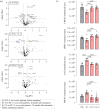Progresses and challenges in Strongyloides spp. proteomics
- PMID: 38008115
- PMCID: PMC10676815
- DOI: 10.1098/rstb.2022.0447
Progresses and challenges in Strongyloides spp. proteomics
Abstract
The availability of high-quality data of helminth genomes provided over the past two decades has supported and accelerated large-scale 'omics studies and, consequently, the achievement of a more in-depth molecular characterization of a number of pathogens. This has also involved Strongyloides spp. and since their genome was made available transcriptomics has been rather frequently applied to investigate gene expression regulation across their life cycle. Strongyloides proteomics characterization has instead been somehow neglected, with only a few reports performing high-throughput or targeted analyses associated with protein identification by tandem mass spectrometry. Such investigations are however necessary in order to discern important aspects associated with human strongyloidiasis, including understanding parasite biology and the mechanisms of host-parasite interaction, but also to identify novel diagnostic and therapeutic targets. In this review article, we will give an overview of the published proteomics studies investigating strongyloidiasis at different levels, spanning from the characterization of the somatic proteome and excretory/secretory products of different parasite stages to the investigation of potentially immunogenic proteins. Moreover, in the effort to try to start filling the current gap in host-proteomics, we will also present the first serum proteomics analysis in patients suffering from human strongyloidiasis. This article is part of the Theo Murphy meeting issue 'Strongyloides: omics to worm-free populations'.
Keywords: excretory/secretory product; immunoproteomics; proteomics; somatic proteome; strongyloidiasis.
Conflict of interest statement
We declare we have no competing interests.
Figures


References
Publication types
MeSH terms
LinkOut - more resources
Full Text Sources
Molecular Biology Databases
Miscellaneous

